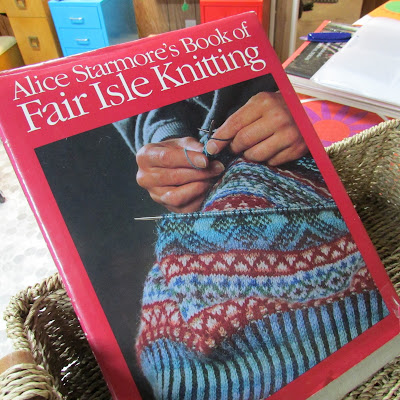There are many advantages to this method:
- The right side of the work is always facing.
- The focus is colour and pattern, shaping is addressed afterwards
- All of the colour change ends are simply trimmed away.
- There is no "jog" at the start of a new round
- Using a traditional "sticky yarn" like Shetland Jumper weight or Lopi and a pattern with lots of diagonal elements makes for a fabric with excellent integrity
I worked out a simple typical pattern with snowflakes on either side of the steek. There is a 3 stitch vertical stripes on either side of an 8 stitch, one dark, one light small fair isle pattern.
The experience is to cut up the middle of the sample and pick up on either side of the stripe for the bands. Cutting is the work of a moment, the longer journey is making the band and facing.
The big surprise for me was the difference in my own picking up stitches habit. Guild members pick up the actual edge of the main knitting and then use the band yarn. Their technique reminded me of picking up a sock heel flap.
I have always picked up with the band yarn one or two edge stitches in.
Perhaps it is because I sew that I don't mind a seam on the inside.
Here is an illustration from one of my Japanese books. You can clearly see 3 stitches picked up for every 4 rows, one stitch in from the edge of the knitting.
I picked up and knit the band, using my regular pattern of 3 stitches every 4 rows. It was not quite satisfactory, so I redid the sample picking up 4 stitches for every 5 rows.
Then I trimmed off the the small colour work pattern...
...and cross stitched the facing in place. Traditional Shetland knitters wash the garment after sewing and stretch it on a frame to complete the process. Careful washing felts the fabric just enough to add more integrity to the fabric, making a reliable, quality piece suitable for generating income for the knitter.
Here is the inside of a cardigan I hand knit 20 years ago. You can see the stranded "floats" on the main fabric look nice and straight and the cross stitched facing still looks fine, even after lots of wear and washing. I think picking up 3 stitches for every 4 rows worked better on my cardigan because the band itself is fairisle.











